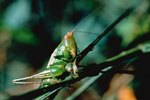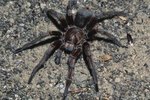
“Mantis” describes a vast array of carnivorous insect species spread all over the world. With so many species, many of which are masters at blending into their surroundings, there is a broad range of diversity in appearance; but mantises, or mantids, share several common characteristics that make them fairly easy to identify -- the most notable of which is the feature that gives them the nickname “praying mantis.”
Order Mantodea
Mantids are insects belonging to the order Mantodea. There are approximately 2,300 known species belonging to this order worldwide, about 20 of which live in the US. These insects are harmless to humans and considered highly beneficial due to their tendency to prey on pest insects, and often are introduced into gardens and crops. Some people even keep them as pets. Although mantids have wings, they prefer to hunt passively, relying on their camouflage to prevent them from being detected as they wait for prey to come close enough to capture.
Praying for Prey
The primary identifying characteristic of mantises is their highly specialized forelegs, which are specially adapted for capturing prey. The forelegs are longer, thicker and more powerful than the other legs, and are lined with sharp spines that help them to snag and to hold onto their prey. When at rest, a mantis folds its front legs, holding them in a position that resembles hands being held together for prayer.
Other Physical Characteristics
Other features that most mantis species have in common include a triangular head with a pair of large compound eyes on either side and three simple eyes set between them. Mantids are able to rotate their heads far enough to look behind them, another feature that makes them excellent hunters. The body of a mantid is typically long, with two sets of thin hind legs. Their wings include a tough pair of forewings that fold over more fragile hind wings, and usually lay flat against the abdomen when not in flight.
Male vs. Female
Adult male mantises generally have more fully developed wings than females. Depending on the species, females may have shorter wings, or no wings, although in some species the wings are fully developed on females. Although the female praying mantis has a reputation for biting the head off of the male after mating, this behavior is limited to only a few mantid species.
References
Photo Credits
-
Jupiterimages/Photos.com/Getty Images
Writer Bio
Jean Marie Bauhaus has been writing about a wide range of topics since 2000. Her articles have appeared on a number of popular websites, and she is also the author of two urban fantasy novels. She has a Bachelor of Science in social science from Rogers State University.



